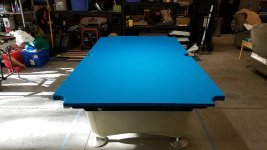The crew came back out and reworked the be cloth. There approach was the following.
1. Take of rails
2. Locate dark shadow/wave and place a screw or socket where the color variation is.
3. Remove staples in-line with the marked spot to reduce tension, pull around the cloth slightly to see if the color variation changes
4. Re-staple cloth when it appears to be reduce/gone.
5. Move on to the next spot, mark with screw/socket; repeat process.
.
.
6. Watch color variations move up and down the cloth, shaking my head at the scenario I'm witnessing.
7. Listen to the guys tell me we are trying to hit a B/B+; meaning if they can reduce the spots to a point where 80% of the table looks good, that equals success.
These guys finally call it quits on this process when we get to a "B," and say the rest of these variations disappear in the next few months as the cloth relaxes. It looks a lot better, but still has several smaller spots along the table edges.
Obviously, I am very annoyed by this process, as they should have reworked the cloth from cloth from start to finish again, the right way, without this ridiculous trial and error process. This was the best they could do, and the guy told me this is a good looking job. "He's been doing this since 1987."
Question: Will these variations reduce over time as the cloth "relaxes?" I'm thinking that it is BS, and it won't, but I thought I would ask the experts here.







